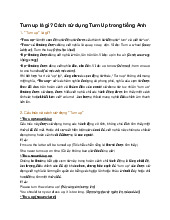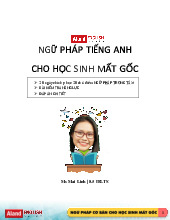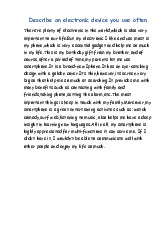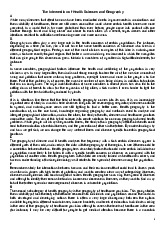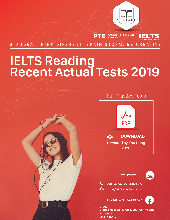

Preview text:
EXAM SKILLS ]
1 6 Read the passage and answer questions 1-9.
MODERN AND POST-MODERN SCULPTURE .· 1
A Modern sculpture has its origins in the work of Frenchman Auguste Rodin. Born into a
modest family in 1840, Rodi'n began his creative journey in the 1860s, a journey that would
lead to him being remembered as the 'bridge' between traditional and modern sculpture.
Before Rodin, sculpture told stories about the past: religion, history, myth and literature.
Sculptures typically left little to the imagination. Figures tended to be idealised in some way
to avoid any imperfections of the model. Rodin can be considered a realist in that he refused
to improve on what he saw in front of him. He considered all of nature beautiful and if a model
was old and wrinkled, he would be portrayed as such. Moreover, like much of the art that he
helped inspire for later generations, his work spoke to the emotions and imagination: both his
and his viewers'. The stories he told were internal and conceptual and there was no right or wrong way to interpret them.
B Rodin was inspired by the fragments of Greek and Roman
C Rodin worked mainly in bronze and was fascinated by the
sculpture that were being discovered by archaeologists
effect of light on irregular surfaces. In particular, he realised
during his time. He was one of the first sculptors to treat
that light bouncing off textured bronze surfaces could create
fragments or parts of figures as complete works of art One
the illusion of movement. He pioneered two new techniques:
of his most famous works is Large hand of a pianist. In this
marcottage and assemblage. Marcottage means creating a
piece he demonstrated one of the characteristics of Modern
new work by putting together pieces from different existing
Art- to make visible things that are not, such as energy,
works. Assemblage, which was further developed later by
sound and rhythm. He sculpted elongated fingers to make
artists like Picasso, began with Rodin's technique of
visible music being played effortlessly. Groundbreaking for
repeatedly casting the same figure and using multiple casts to
its time, this concept has been taken forward by sculptors create a new piece. right up to the present day.
D The Late Modern Period (1900 to 1945), which saw the rise of
extreme distortion* - and then abstraction** - in sculpture
can be seen as a natural development from the pioneering
work of Rodin. Romanian French sculptor Constantin Brancusi
was one of the leading exponents of this style. He attempted
to reduce the physical world to three basic forms: egg, pebble
and grass blade. The development of Rodin's assemblage also
continued and came to represent the building of sculptures
rather than carving or moulding them. Picasso's sculptures
were called 'Constructions' and used a range of different
objects and materials. The rise of minimalism, a movement
that reduces sculpture to its most essential features, comes
very much from this tradition.
E Thanks to the work of these 'forefathers', Modern sculpture
embraces many forms and styles. It is increasingly common to
see it created outdoors, often in view of the spectators. One
form of outdoor sculpture is known as Earth Art, which is based
on nature and makes use of rocks, branches, leaves, dirt, soil,
water and other naturally occurring materials. Another offshoot
is kinetic sculpture - sculpture that involves moving parts.
Mobiles are one such example. Early examples had moving
parts powered by wind or touch and later some were even
powered by machines. Other pioneering forms of Modern
sculpture include ice sculptures used in culinary art and
sound sculptures - such as Aeolian harps 'played' by the wind. UNIT 03 READING
F Art installations are another example of how sculpture has
G In fact, these days sculpture increasingly involves the public.
developed in the Modern and Post-modern eras. They can be
The use of digital technology has further increased the
defined as a work of art consisting of multiple components,
possibilities of creating art that reaches everyone. Digital
often though not necessarily in mixed media, usually exhibited
installations allow artists to 'play' with the boundary between
in an indoor gallery space in an arrangement specified by the
the real world and virtual reality and give new opportunities
artist. Installations are multi-sensory experiences built for a
for active participation in the artwork by the spectator. Touch,
specific time and space. They are often highly imaginative and
physical participation and social interaction are now common
bring different materials together to create something original
features of the experience of going to see art. Modern
and unexpected. The audience is drawn to them because they
sculpture has come a long way since Rodin got the
are immersive, often allowing audience participation. One
ball rolling in the 1860s, and the future promises
such installation was Cloud City, a huge construction created limitless possibilities.
by Argentinian sculptor Tomas Saraceno. It consisted of 16
interconnected modules, 16.5 by 8.5 metres, displayed on the
roof of the Metropolitan Museum of Art in New York. Visitors
were able to walk up and inside the modules.
*distortion - twisting out of shape
**abstraction - depicting ideas, not actual objects Questions 1-6
Do the following statements agree with the information given
in the reading passage above? Write TRUE
if the statement agrees with the information FALSE
if the statement contradicts the information
NOT GIVEN if there is no information on this
1 Before Rodin, sculpture was very realistic.
2 Rodin expected people to interpret his sculptures in their own way.
3 Rodin studied the sculpture techniques of the Greeks and Romans.
4 Rodin felt that incomplete figures were still artistic works.
5 His Large Hand of a Pianist tries to convey music being played.
6 Rodin believed the surfaces of sculptures should be smooth. Questions 7-9
Choose the correct letter, A, B, C or D. 7 Assemblage
A was first used by Pablo Picasso.
B uses only three basic forms.
C involves several artists working on the same theme.
D creates a single composition from a number of versions of an individual.
8 What is the purpose of paragraph E?
A to explain the meaning of Earth Art
B to explain how kinetic sculpture has evolved
C to introduce the idea of outdoor sculpture
D to show examples of innovative forms of Modern sculpture 9 Art installations A always use mixed media. B are always outdoors.
C usua\\y a\\ow viewers to interact with them. D typically last a long time.
